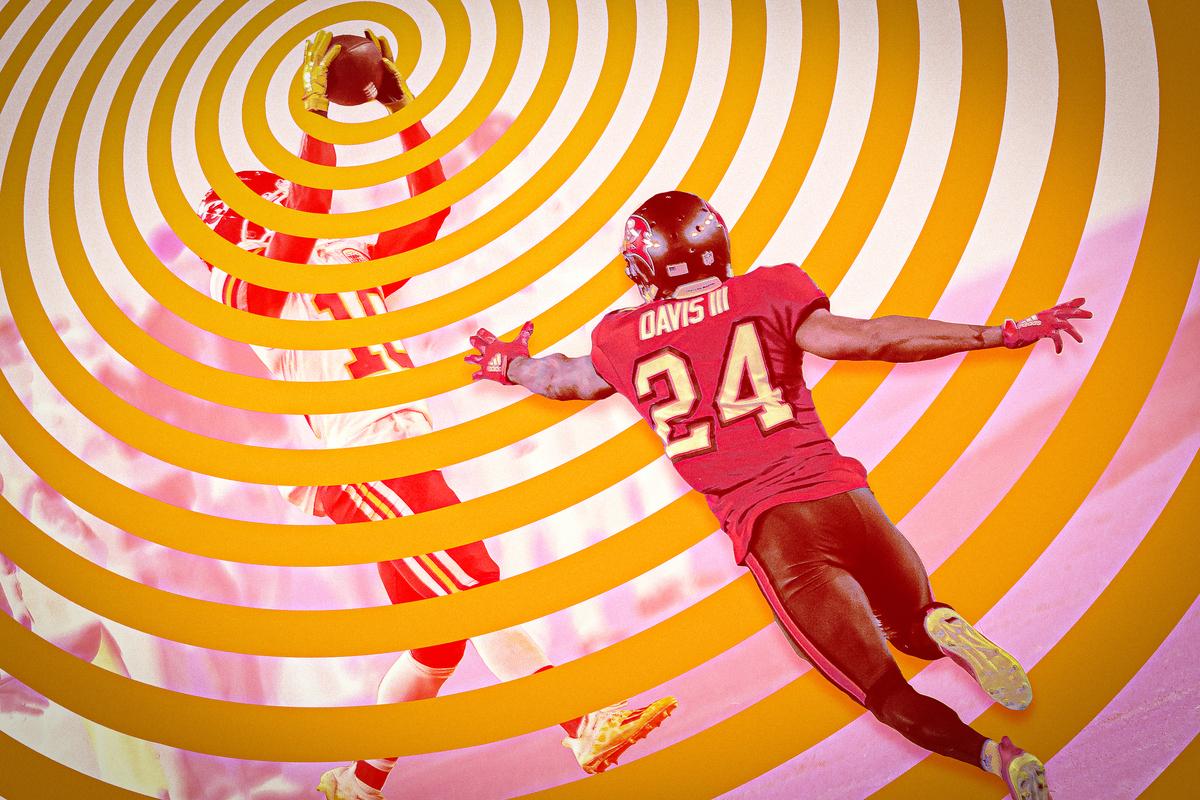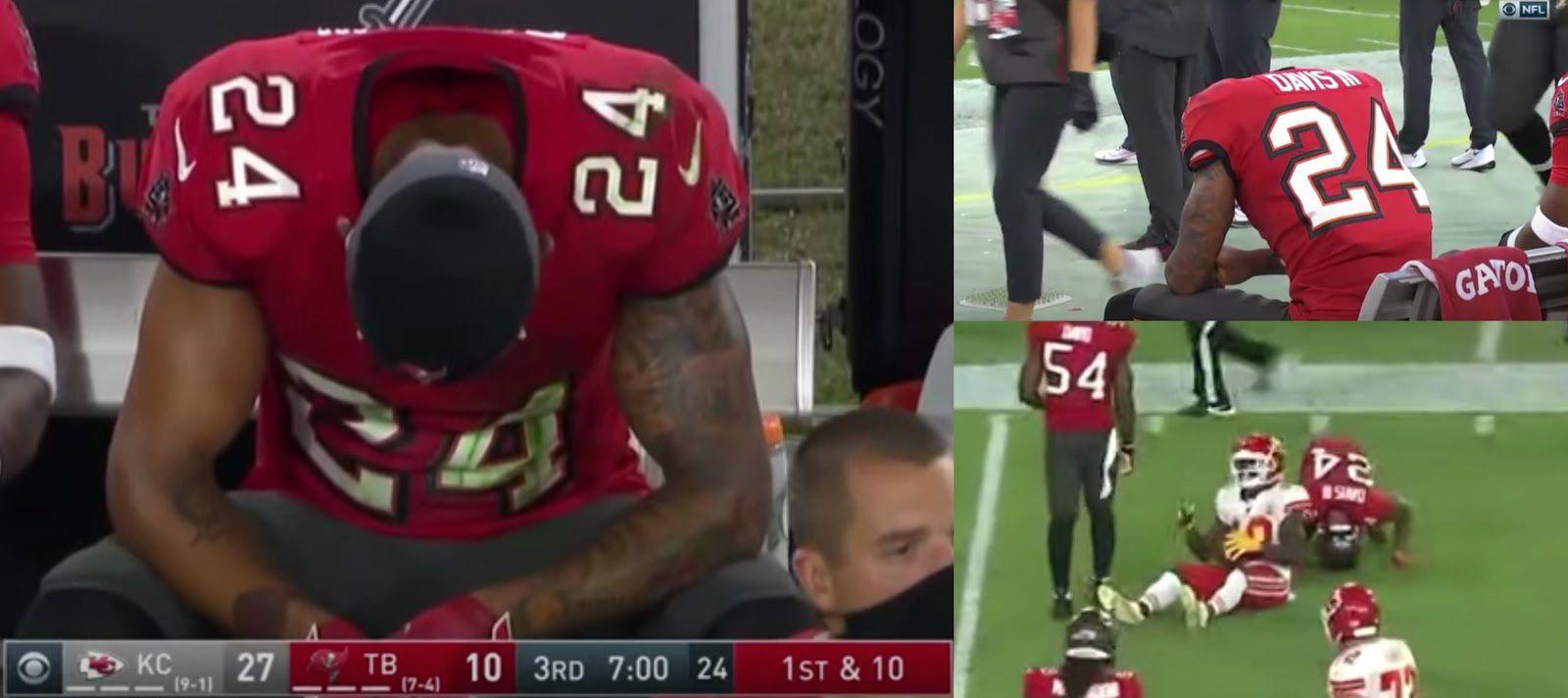
There is no greater sports indignity than the Cornerback Having a Bad Day Graphic. I would rather get dunked on by prime Vince Carter than have Sunday Night Football flash a box showing that the receiver I’m guarding has caught 11 of 11 targets for 172 yards and three touchdowns. At least if I’m on a poster, you might not see the name on the back of my jersey. But I’ll forever know that former Chiefs cornerback Phillip Gaines once allowed six catches for 209 yards and two touchdowns, and that former Cowboys cornerback Mike Jenkins made the mistake of looking directly into the camera while the broadcast put up a graphic showing that he had allowed catches on 100 percent of the passes targeting him in that game.
Buccaneers cornerback Carlton Davis should count his blessings that no such graphic was made for him when Tampa Bay played the Chiefs in Week 12, in what turned out to be a Super Bowl preview. CBS didn’t put up a lower-third with his stats—it just cut to him looking dejected, defeated, and distraught after allowing catch after catch to Kansas City’s Tyreek Hill.

Hill finished the game with 269 yards, the most by any receiver in a game since Julio Jones’s 300-yard game against the Panthers in 2016. When matched up with Davis, Hill had nine catches on nine targets for 211 yards and three touchdowns. Davis also gave up catches to Travis Kelce and Demarcus Robinson, and was credited with 236 receiving yards allowed.
It’s hard to explain how ridiculous these numbers are. This was the worst cornerback outing of the year—no one else even allowed 200 receiving yards in a single game this season. According to Pro Football Focus, it was the most yards allowed by any defender in one game since Bills cornerback Justin Rogers allowed 247 against the Jets in 2013. (Rogers was cut weeks later; Davis is still one of Tampa Bay’s starting corners.) And I can’t find an example in the PFF database of a cornerback allowing more than 211 yards in a matchup with one receiver; the closest thing I could find is Antonio Cromartie allowing 208 yards to Demaryius Thomas in 2014. (I checked the stats week by week going back to 2009 before my clicking finger literally cramped up and I figured that 12 years without a similar failure was telling enough.)
That we’re getting a rematch of this matchup in the Super Bowl seems absurd. You’d expect the biggest cornerback embarrassment of the past decade to have taken place in a game where a contender played a team like the Jets—not the eventual NFC champions. This would be like if the Lakers played the Raptors in the NBA Finals in the same year that Kobe Bryant scored 81 points against them, and especially against Jalen Rose. But that didn’t happen—the Raptors went 27-55 that season, because generally teams that give up unbelievable individual performances tend to suck. The Bucs, of course, do not.
Reading this so far, you probably think Davis is an awful player on an otherwise great team. But that’s not the case. In 2019, Davis ranked second in the NFL with 19 passes defensed. According to Pro Football Reference, he was one of just 10 players to hold quarterbacks under a 50 percent completion percentage on passes thrown his way—and the only one to be targeted more than 100 times. He wasn’t bad this season, either. If you take out that one game against the Chiefs, Davis allowed 45 catches on 78 targets for 547 yards with two touchdowns and four interceptions. That’s good for a 66.6 passer rating against, which would have been the 12th-best of any defender to play at least 50 percent of their team’s coverage snaps. Keep that Chiefs game in, and Davis had an 88.2 passer rating against, which ranks 53rd. The one game against Kansas City is responsible for 21 percent of Davis’s receptions allowed, 30.1 percent of his yards allowed, and 60 percent of his touchdowns allowed.
There were five games this season in which Davis was credited with fewer than 20 passing yards allowed. Against Aaron Rodgers and the Packers in Week 6, he had four pass breakups and turned a throw to Davante Adams on a slant into an interception. He held Michael Thomas to zero catches on three targets in Tampa Bay’s divisional-round win over the Saints, and then called Thomas “Slant Boy” on Twitter afterward. Davis isn’t elite, but he’s done a solid job the past two years while drawing a high number of targets.
Davis is a good cornerback … but it didn’t matter against Patrick Mahomes and Hill. Sometimes, Davis stuck to Hill like dog hair on a sweater—and Mahomes simply slotted the football in the football-sized hole where Davis wasn’t. According to NFL Next Gen Stats, Hill had 0.7 yards of separation from Davis at the moment when the below pass was caught. That’s roughly the distance from your eyes to the screen where you’re reading this.
And what the hell are you supposed to do about this?
Other times, Davis did legitimately get burned. But the blame should fall on the Buccaneers’ defensive game plan for putting him in a position to let that happen. Tampa Bay opened the game with just one high safety. If that safety was paying attention to, say, Travis Kelce or Sammy Watkins on a given play, Davis was left in single coverage against Hill. You know who can guard Hill in single coverage? Seriously—do you know anybody who can guard Hill in single coverage? Let the NFL know about them!
Mahomes seemed flabbergasted that this was the Buccaneers’ approach. “It was man coverage with no one over the top, and we don’t get that a lot especially with that guy and his ability. Whenever we do, we try to take advantage of it,” he told reporters after the game. With the Bucs defense in single-high coverage, Hill racked up 203 yards in the first quarter. No other NFL receiver had that many yards in a full game all season. If Tampa Bay kept playing that way, Hill would’ve broken the all-time NFL receiving record (336 yards) by halftime and taken the rest of the day off.
So the Bucs switched things up. USA Today’s Steven Ruiz explained that they primarily used the “solo” coverage that the 49ers played in last year’s Super Bowl during the second half of that Week 12 game. For CBS, Jared Dubin analyzed which defenses the Bucs played more in the second half than the first, demonstrating how they moved into more passive looks. The Ringer’s own Kaelen Jones wrote about how the Bucs played significantly more two-man coverage (two high safeties, man defense everywhere else) and how that will probably be their best option in the Super Bowl.
The most extreme defense Tampa Bay tried against the Chiefs is this one, where the Buccaneers’ two safeties seem to be assigned to strict double-teams on Hill and Kelce. Tampa Bay committed four of its 11 players to two guys, leaving the other seven to rush the passer, stick with the other three receivers, and defend against a Mahomes scramble. It looked awkward, but it worked.
“The Bucs worked double-teams against us on those two, and we’ve got to work on that and make sure we’ve got those things covered,” Chiefs head coach Andy Reid said this week. Hill complimented Tampa Bay defensive coordinator Todd Bowles, saying that the adjustment of “bringing the safety over the top to double me and Kelce slowed us down a lot.”
But Hill still had 66 yards and a touchdown in that game after his prolific first quarter—and it feels like the Bucs committing to permanent double-teams on Hill and Kelce in the Super Bowl would just be asking for Watkins to pick up multiple first downs, Clyde Edwards-Helaire to take advantage of seemingly endless space, and Mecole Hardman to break free for a long touchdown. As The Ringer’s Danny Heifetz wrote earlier this week, the Chiefs offense presents an unsolvable problem for NFL defenses. There’s simply no surefire way to stop it.
Hill torching Davis so thoroughly earlier this season doesn’t tell us a ton about what will happen in the Super Bowl. Well, except that we can pretty much guarantee it won’t happen again. There’s no way the Bucs will leave Davis alone on an island with no safety help this Sunday. That it happened even once is a testament to the inevitability of the Chiefs offense. A smart defensive coordinator thought it’d be a good idea to isolate Hill on a good cornerback and hope to limit all of the Chiefs’ other playmakers—and Hill almost set the NFL single-game receiving record by halftime.
For Davis, it’s lucky that the Chiefs and Bucs met earlier this season. If not, Tampa Bay might have headed into the Super Bowl with the game plan to have Davis guard Hill one-on-one. I have a funny feeling that there would have been a graphic this time around.